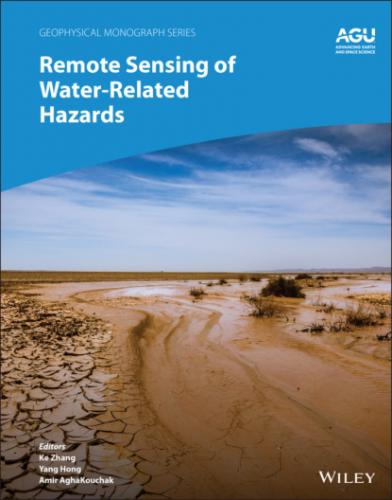1.3. OBJECTIVES AND ORGANIZATION OF THE BOOK
This book reviews recent advances and presents new studies in remote sensing of floods, droughts, rainfall‐triggered landslides, and their associated secondary or cascading hazards, including, but not limited to, progress in remote sensing of precipitation, improvements in the integration of remote sensing data within computational modeling, near‐real‐time observations of storms and tornados, multisensor integration, integrated approach for predicting flood and landslide cascading hazards, and multi‐indicator and multisensor approaches for quantifying drought impacts. The main objective is to offer an up‐to‐date perspective on remote sensing of water‐related hazards, drawing on contributions from scientists with different backgrounds. This book is organized into three parts, with each of the 13 chapters representing an independent but interconnected topic related to water hazards (Figure 1.1).
Part I: Remote Sensing of Precipitation and Storms
Precipitation is a key variable in global water and energy cycles, and a driver of many types of extreme events. Understanding the underlying mechanisms triggering water‐related natural hazards and monitoring and predicting these hazards require accurate precipitation data. Remote sensing of precipitation provides a valuable source of quasi‐global and near real‐time information, widely used in hydrometeorological studies and hazard monitoring. In chapter 2, Tang et al. summarize recent progress in global satellite remote sensing of precipitation and then focus on assessing the accuracy of the retrospective Integrated Multi‐satellite Retrievals for Global Precipitation Measurement (IMERG). Comparing IMERG with the other mainstream satellite and reanalysis products, they discuss advantages and disadvantages of IMERG relative to the other products. This chapter provides a valuable reference for both users and developers who are interested in practical applications, model development (bias correction and uncertainty assessment), and algorithm development of satellite precipitation products.
Figure 1.1 Structure and organization of this book.
Tornadoes, usually born during thunderstorms and accompanied by hail and/or heavy rainfall, are vertical funnels of rapidly spinning air and driven by extreme gradients in atmospheric pressure and temperature. Ground‐based, mobile Doppler radar is one of the most effective and reliable tools for observing and monitoring tornadoes. In chapter 3, Bluestein starts with a brief history of the different types of mobile radars and their properties (e.g., wavelength, type of modulation, and polarization technique). The chapter then describes how to determine (a) the distribution of wind in tornadoes and their parent storms, (b) the development of pretornado vortex signature, and (c) the tornadic vortex signature itself using ground‐based, mobile Doppler radars. Finally, this chapter discusses the potential new radar techniques for ground‐based mobile radars to improve the ability to probe tornadoes.
Part II: Remote Sensing of Floods and Associated Hazards
As one of the deadliest natural hazards in the world, floods have historically received a great deal of attention in the remote sensing community. In chapter 4, Zhang et al. integrate remote sensing, hydrological‐hydraulic modeling, and Geographic Information System (GIS) techniques to map inundation and quantify flood hazard risks. Their approach allows for filling the information and knowledge gap in data scarce regions. More specifically they combine a two‐dimensional coupled hydrology‐inundation model with satellite remote sensing data from the Moderate Resolution Imaging Spectroradiometer (MODIS) and the Phased Array Type L‐band Synthetic Aperture Radar‐2 onboard the Advanced Land Observing Satellite‐2 (ALOS‐2 ALOS2/PALSAR‐2) to map flood hazards and their impacts in Nyaungdon Area, Myanmar.
In chapter 5, Chen et al. use a case study of remote sensing of floods triggered by Hurricane Harvey in Houston, Texas, USA. This chapter investigates the detectability of extreme rainfall through multisensor remote sensing and the simulation performance of the induced flooding via multidimensional modeling. It introduces a multidimensional modeling framework based on the Coupled Routing and Excess Storage (CREST) model family, designed to utilize multisensor remote sensing products for hydrologic applications. The chapter demonstrates that the integration of multisensor remote sensing precipitation and multidimensional modeling has a high potential to provide accurate and timely flood warning of the extreme events in a changing climate.
Hydrological modeling is a key tool for flood forecasting and early warning. Remote sensing datasets have allowed not only better parameterization of hydrological models but have also moved toward large‐scale, near‐real‐time flood/inundation forecasting. However, configuring and executing stand‐alone hydrologic models can be difficult, especially in regions with a lack of high‐level modeling and data analysis expertise. In chapter 6, Wan et al. present a new web‐accessible lumped hydrological modeling framework for researchers and practitioners to facilitate the organization of hydrological data, execution of hydrologic models, and analysis of results. The chapter shows how the efficiency of data processing and query can be improved through adopting the Hadoop Distributed File System (HDFS) and the Apache Hive concept. The authors integrate the lumped CREST and Hydrological Model (HyMOD) as a proof of concept in this framework.
Rainfall‐triggered landslides are often associated with extreme precipitation events and floods, causing significant loss of life and property. Understanding the interactions between flood/rainfall events and landslides is fundamental to improve current landslide monitoring and prediction models. In chapter 7, Zhang et al. develop a coupled flood and landslide disaster early warning system for operational use by coupling two distributed hydrologic models, the Coupled Routing and Excess Storage (CREST) model and the Sacramento Soil Moisture Accounting (SAC‐SMA) model, with two physically based landslide prediction models, the Slope‐Infiltration‐Distributed Equilibrium (SLIDE) model and the Transient Rainfall Infiltration and Grid‐Based Regional Slope‐Stability (TRIGRS) model. The Bayesian Model Averaging method is then applied to average the outputs of the ensemble members to produce an integrated outcome. This ensemble‐based framework allows quantifying the uncertainty of the predictions and the probability distributions of anticipated events, enhancing disaster preparedness and prevention.
Advances in sensor technology make high‐resolution SAR imagery data with a spatial resolution as fine as 0.3 meters available for distinguishing manmade objects in urban areas, such as bridges, roads, and drainage systems. In chapter 8, Liu
